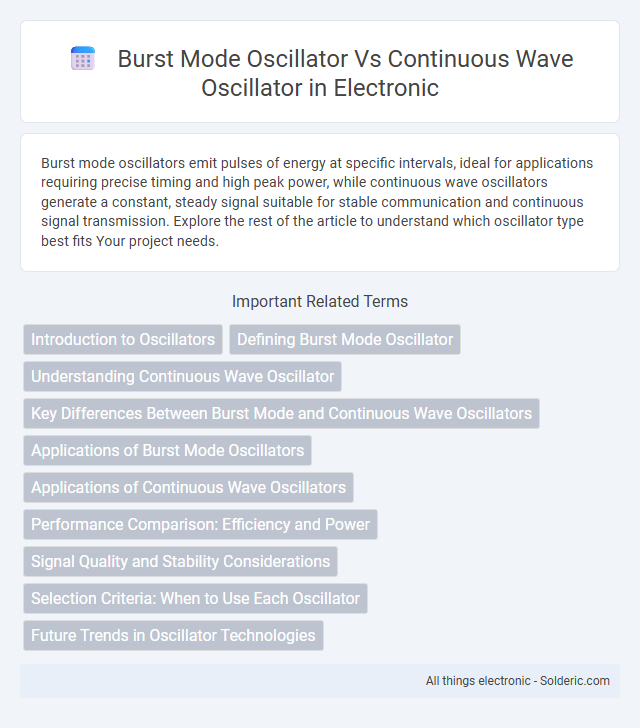Burst mode oscillators emit pulses of energy at specific intervals, ideal for applications requiring precise timing and high peak power, while continuous wave oscillators generate a constant, steady signal suitable for stable communication and continuous signal transmission. Explore the rest of the article to understand which oscillator type best fits Your project needs.
Comparison Table
| Feature | Burst Mode Oscillator | Continuous Wave Oscillator |
|---|---|---|
| Operation | Generates short pulses or bursts of oscillations | Produces a continuous, steady oscillation |
| Output Signal | Intermittent, time-limited signals | Constant, uninterrupted waveform |
| Applications | Pulsed radar, digital communication, sensor excitation | Radio transmission, continuous-wave radar, signal generators |
| Power Consumption | Typically lower due to intermittent operation | Higher, continuous power usage |
| Frequency Stability | Moderate; depends on pulse characteristics | High; stable frequency output |
| Complexity | More complex timing control circuitry needed | Simpler continuous waveform generation |
Introduction to Oscillators
Oscillators generate repetitive signals essential for communication and signal processing systems. Burst mode oscillators produce short, controlled bursts of oscillation, ideal for radar and pulsed applications requiring precise timing. Continuous wave oscillators deliver steady, unbroken signals suitable for applications needing constant frequency output, such as radio transmission and continuous signal generation.
Defining Burst Mode Oscillator
A burst mode oscillator generates a series of short, high-frequency pulses separated by intervals of inactivity, enabling precise control over pulse timing and duration. This mode is ideal for applications requiring intermittent signal transmission, such as radar systems and pulsed communication. In contrast, a continuous wave oscillator produces a constant, uninterrupted sinusoidal output, suitable for steady-state signal generation and continuous-wave radar.
Understanding Continuous Wave Oscillator
A Continuous Wave (CW) oscillator generates a steady, unmodulated sinusoidal waveform at a single frequency, essential for applications requiring constant signal transmission such as radar and communication systems. Unlike burst mode oscillators that emit pulses or bursts of oscillations intermittently, CW oscillators maintain a stable output, enabling precise frequency control and minimal phase noise. The continuous nature of the CW oscillator signal allows for effective long-range detection and consistent carrier wave generation in RF applications.
Key Differences Between Burst Mode and Continuous Wave Oscillators
Burst mode oscillators generate intermittent pulses with precise timing intervals, ideal for applications requiring controlled burst signals and reduced power consumption. Continuous wave oscillators produce a steady, uninterrupted waveform, making them suitable for constant signal transmission and stable frequency output. Your choice depends on whether the application demands short, periodic bursts or a continuous, stable frequency source.
Applications of Burst Mode Oscillators
Burst mode oscillators generate pulsed signals ideal for radar systems, ultrasonic imaging, and communications where precise timing and controlled energy bursts are essential. Unlike continuous wave oscillators that provide constant frequency output for applications like signal carriers and local oscillators, burst mode oscillators enhance detection resolution and reduce power consumption. Your choice of burst mode oscillators suits applications requiring synchronized burst signals, such as pulse-Doppler radar and time-domain reflectometry.
Applications of Continuous Wave Oscillators
Continuous wave (CW) oscillators provide a stable and uninterrupted sinusoidal output signal, making them ideal for applications in communication systems such as radio transmitters and radar where consistent frequency and amplitude are critical. Your signal quality in spectroscopy, continuous-wave laser sources, and signal processing also relies on the steady output from CW oscillators. These oscillators enable precise frequency control in instrumentation and measurement devices, supporting high-resolution and accurate data acquisition.
Performance Comparison: Efficiency and Power
Burst mode oscillators deliver high peak power in short pulses, making them highly efficient for applications requiring intermittent energy bursts, such as radar and pulsed laser systems. Continuous wave oscillators maintain constant power output with steady efficiency, ideal for communication systems and continuous signal transmission. Your choice depends on whether peak power or sustained output efficiency is more critical for your application's performance requirements.
Signal Quality and Stability Considerations
Burst mode oscillators generate short, repetitive pulses that offer high signal precision with reduced phase noise, making them ideal for time-domain applications needing clear, stable bursts. Continuous wave oscillators deliver a steady, uninterrupted signal with excellent frequency stability, benefitting applications requiring constant output and minimal frequency drift. Your choice depends on whether signal consistency or burst precision is critical for the application's performance requirements.
Selection Criteria: When to Use Each Oscillator
Burst mode oscillators are ideal for applications requiring short, high-energy pulses such as radar and pulsed laser systems, where precise timing and energy control are critical. Continuous wave oscillators suit situations needing steady-state signals like communication transmitters and continuous wave Doppler radars, offering stable frequency and amplitude output. Selection depends on factors like pulse duration, power requirements, and the need for signal continuity versus pulsed operation.
Future Trends in Oscillator Technologies
Future trends in oscillator technologies emphasize enhanced energy efficiency and miniaturization, with burst mode oscillators gaining traction for low-power, high-precision applications such as wearable devices and IoT sensors. Continuous wave oscillators continue to evolve, integrating advanced semiconductor materials like GaN and SiC to achieve higher frequency stability and reduced phase noise in telecommunications and radar systems. Innovations in MEMS-based oscillators are bridging both modes, offering scalable solutions with superior thermal stability and tunability for next-generation wireless communication and autonomous systems.
burst mode oscillator vs continuous wave oscillator Infographic

 solderic.com
solderic.com